Hey, this post is late because I am bad at adulting. As a result, it pushed down some terrific reviews from Jeff that are actually thoughtful and smart and stuff. You should be sure to read those also, probably before you get to these.
I’ve always been prone to shameless, embarrassing nostalgia. If a song reminds me of someplace specific, or of a particular group of friends, I will like that song more. Period. It’s not something I’m proud of — it feels like an incredibly basic bit of reacting, devoid from any real introspection or thought — but it’s also kind of pointless to ignore.
And, let’s be real, most readers of superhero comics in my age cohort are probably keeping their hobby gassed up with 93 octane nostalgia, so it’s not like I’m alone. But reading review copies of the DC books triggers all-new, all-different nostalgia than “regular” comic reading. It’s taken me some time to work out why that is, but I think it finally crystallized as I read the five annuals that DC sent around this week, and ironically it kinda hearkens back to my first post here on Wait, What?.
That was a nostalgic ramble (cf. me as a basic nostalgia beast, above) on the first comic that got me reading DC books regularly, and an attempt to dissect what made it so sticky for me. What I mentioned in passing but maybe should’ve focused on was that I read it because I was at summer camp and didn’t have anything else.
Which brings me to annuals. I’m going to write the following without doing even the most cursory internet research, because this is one of those times where I think my perception of truth is more relevant than whatever the actual truth is, so here are some things that I remember to be true about the superhero (mainly Marvel) comic book annuals of my youth:
- They came out in the summer
- They contained one thick, generally self-contained story
- The tone of that story was often wildly different from the regular tone of the book
- They were rarely by a book’s entire regular creative team, but were instead often by the regular writer with an unusual artist (and, much different from today, that artist was often a BIGGER name than the regular book’s — an Art Adams or an Alan Davis, say, who maybe couldn’t keep up a monthly schedule but who was perfect for this sort of one-off)
- As a result of the last three items, you could read the annual of a book even if you had never read the series before
Again, the summer thing is key. Annuals weren’t something that really fit into my allowance-based comic-buying budget. But on summer vacations out to the delightfully trashy Maryland shore, my parents would be more willing to buy things like extra comics, and I’d be more willing to choose whatever the hell was on the spinner racks at the weirdly understocked beach-town bookstores, and anyway an annual was perfect for being on vacation because you could read it without needing to pre-read a bunch of earlier issues, and if you accidentally left it in the rental beachhouse, well, it didn’t REALLY leave a hole in your collection.
(It’s probably not coincidental that my interest in annuals totally fell off when Marvel started using them for TERRIBLE line-wide crossovers, thus eliminating the “free-standing slab of comics” element that made them so perfect in my eyes. As usual, The Evolutionary War ruined everything.)
Thinking about the annuals that stick in my memory — New Mutants annual #3! X-Men annual #10! The crossovers betweeen Avengers and West Coast Avengers! — the other thing that keeps coming to mind is the taste of donuts. Not just any donuts, but fresh-baked, custom-dipped donuts from the Fractured Prune, then (years before an ill-fated attempt to franchise) unique to Ocean City, Maryland, and the kind of splurge junk food my family only ever ate on vacation. That association probably just means that I sat around reading comics during breakfast, but it also kinda feels like a decent food metaphor for how I think of annuals in general.
ANYWAY, this is all a lengthy preamblish way of saying that I’m predisposed to love annuals but I also never, ever seem to buy them, because doing so would intrisically undermine what I remember loving about them. Nostalgia is a complicated, stupid thing, and gravity always wins.
Soooooooooooooooooo how would I feel if a bunch of annuals just randomly showed up in mid-summer, mainly for books I don’t follow faithfully? Let’s see!
Gotham By Midnight Annual #1, by Ray Fawkes, Christian Duce, Lee Loughridge. Using the nostalgic rambling above as sort of informal criteria for judging the success of an annual, this is a pretty darned good one. The detective/procedural story is well-suited for episodic standalones (cf. like 80% of what’s on network TV), and this is no exception. It’s a brisk, pleasantly sleazy game of supernatural cops-and-robbers with added comic book elements (the Spectre, played here as a sort of divine version of the Hulk) for texture.
For the annual, the art steps away from Ben Templesmith’s style ; Christian Duce still manages to be atmospheric while being much more generic and accessible. (In my imaginary “bought this at the beach on a whim” scenario, that’s probably a positive.) A solid, standalone extra-length story — basically the comic book equivalent of a beach read (or Airport Book??!?).
Lobo Annual #1, by Cullen Bunn, Robson Rocha, Guillermo Ortega. I can’t figure out this incarnation of Lobo at all. When the original Lobo worked, it was because he was pitched at a berserk tone of dark comedy. (His defining stories were drawn by Simon Bisley, for god’s sake.) The violence was extreme in the name of satire, not in the name of actual cool, and really they probably could’ve just drawn a line under the whole concept after his fistfight with Santa Claus.
Which is to say that I have trouble engaging with this comic on a real, fundamental level, because any nostalgic attachment I have to the old Lobo doesn’t convey to this reimagining, and the new version himself does nothing in particular to earn my interest now. He’s a fairly nondescript space assassin whose narrative captions tend toward genre-standard fare like “He’s even more confident than I am … and that’s saying a LOT. I turn that confidence against him.” He’s also stuck in a very post-Guardians of the Galaxy version of space, which is not exactly a tonal match.
And all of that is a shame, because the idea of Lobo trying to assassinate Sinestro is a fun one, and somewhere underneath the book that’s actually here is a much livelier, more entertaining book trying to get out. To its credit, the book does a good job simultaneously telling a mostly complete story while still setting up plot points for the ongoing series, but in the end the whole thing feels too rote to really excite.
The art from Rocha and Ortega evokes a similar reaction: it’s perfectly cromulent (a word I learned from Jeff Lester! I feel like a real Wait, Whatter now!) sci-fi art in the current DC house style, but it’s miles away from what I want from a Lobo comic (which is, let’s be honest, Simon Bisley). As a Lobo story, this isn’t close to what I want; as a kinda generic DC sci-fi book, it’s fine. Would’ve killed off an inoffensive 15-ish minutes on a bad beach day and then been forgotten forever.
The Flash Annual #4, by Van Jensen, Bong Dazo, and Norm Rapmund. Two classic annual tropes at play here: the gathering of a team across time and/or space, and the annual that doesn’t feature the title hero at all but instead provides background for (presumably) a story that’s coming up in the main book. It’s a smart approach, because it lets you use the space of an annual to tell a full story while still staying tied directly into what you have going on in the monthly title. The gathering of a team of bad guys is pretty familiar at DC these days (there was a point where it seemed like every issue of Green Lantern featured at least three recruitment scenes), but Jensen does a yeoman’s job of it here.
The art from Dazo and Rapmund isn’t quite up to selling the different timeframes Jensen’s story asks for — a character who’s meant to be a Maori woman from 1957 looks almost indistinguishable from a Warren Ellis character from 1999 — and also doesn’t always do a great job establishing physical space, which is a problem in a story that prominently features superspeed as a plot device. Interestingly (at least to me!), a lot of panels have detail elements (and a generally static look) that reminds me of Ian Churchill, which makes me wonder how much frequent Churchill inker Rapmund is responsible for things I thought I didn’t like about Churchill’s art.
The book didn’t quite do the job of getting me personally interested in whatever it is that Zoom is planning to do to the Flash, but I can at least sort of see what they’re going for here. A potentially smart use of the annual form, even if the execution was somewhat disappointing.
Deathstroke Annual #1, by Tony Daniel and James Bonny, Tyler Kirkham, and Arif Prianto. Was it on a recent Wait, What that one of the guys was explaining how in a Star Trek tie-in comic set between the second and third film, the creative team resolved the cliffhanger from Star Trek 2, told an extended story, and then managed to reset things so the cast was in an all-but-identical cliffhanger situation heading into Star Trek 3? Or was it another podcast? Or am I making this up altogether in my addled head?
It doesn’t really matter, except that I’m pretty sure that’s exactly what’s happening here: I think this issue starts after the last issue of Wonder Woman (or maybe Deathstroke?), sends them off on a related-but-inessential journey of the mind/spirit, and then returns them right back to the start of the issue again, functionally unchanged. So if you’re reading the series without the annuals, maybe you just never know this happened? I’m guessing?
Whatever the reasoning behind it, this was a book that requires a level of caring about Deathstroke as a character and a concept that I simply don’t possess. A more well-crafted annual, faced with that problem, might MAKE me want to know more about the character and drive me to the solo book.
This is not that annual, but maybe it’ll do something for you if you’re really into New 52 Deathstroke.
Batgirl Annual #3, by Cameron Stewart and Brenden Fletcher, Bengal, David LaFuente, Ming Doyle, Mingjue Helen Chan, Gabe Eltaeb, and Ivan Plascencia. This, on the other hand, is just about a perfect annual. Told in four chapters, each with a separate guest star, each with a top-notch artist, this is a book that not only made me want to read more about this version of Batgirl (I’m behind on the series, although I’m trying to keep up), but it uses its increased length to feature extended appearances by Dick Grayson (in his role from Grayson), Spoiler, Batwoman, and the cast of Gotham Academy — and made me want to know more about where each of them stand in current DC continuity.
(Well, except for Grayson, but that’s just because Grayson is one of my favorite books going at the moment and I didn’t really need any further incentives.)
All of the art teams were terrific, although I’m especially fond of Bengal’s work, which somehow (to my eyes) manages to marry Takeshi Miyazawa with Kyle Baker. The book’s plot, although not particularly complicated, is engaging enough. It provides reasonable excuses for its guest stars to appear, manages the connective tissue between the chapters well, and resolves itself sufficiently to feel self-contained. This was great, all the way around.
If I’m going full-nostalgia (and at this point, why the hell not), I found this weirdly reminiscent of one of my favorites of the beach-purchased annuals that prompted this whole stupid post: Avengers Annual #16, also split into chapters, also with each chapter featuring different guest stars and a different top-tier art team of the era.
(Romita Jr./Siekiewicz, as seen above! Guice/Nowlan, as seen below! Rogers/Layton, as not seen here but man is it glossy!)
That stupid beach-week purchase actually deepened my interest in Marvel’s characters AND a bunch of their artists, and I kind of think this Batgirl annual would’ve done the same thing. Somehow, all these years later, despite the inevitable march toward entropy and doom, a really well-executed superhero comic book annual still manages to taste just like really good donuts. Go figure.
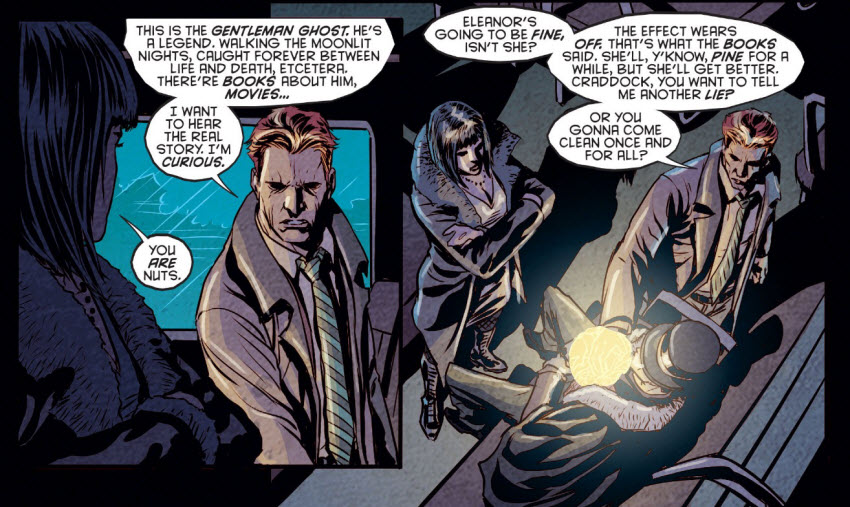
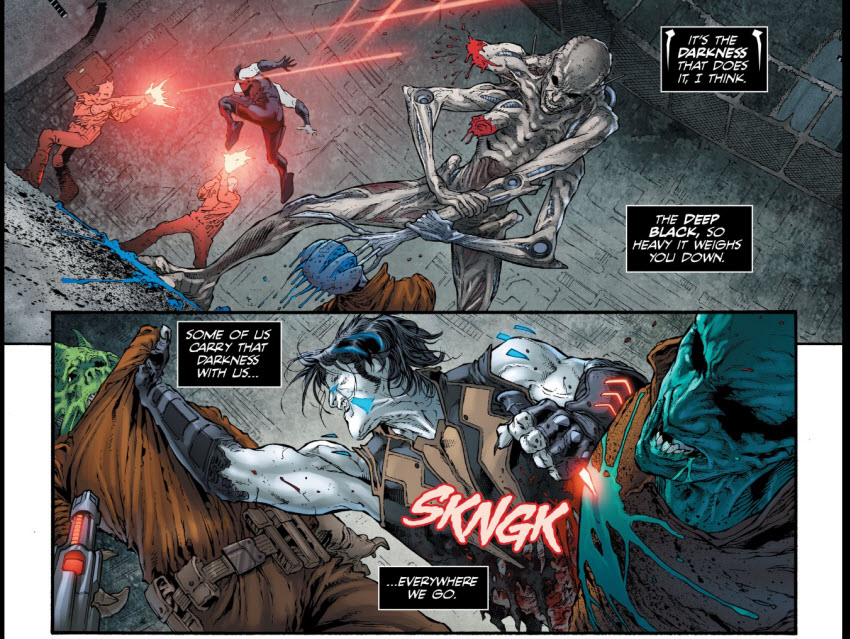
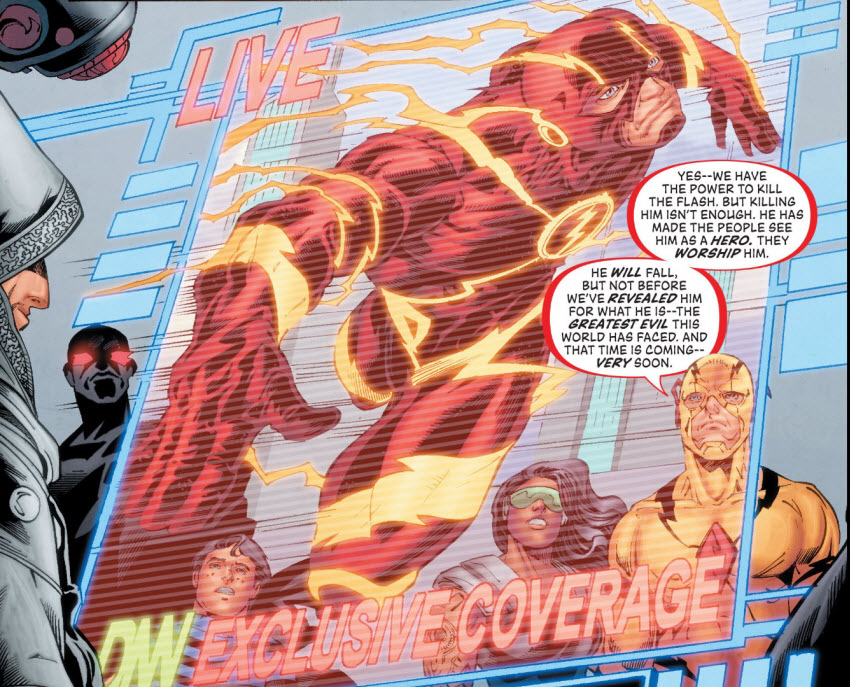
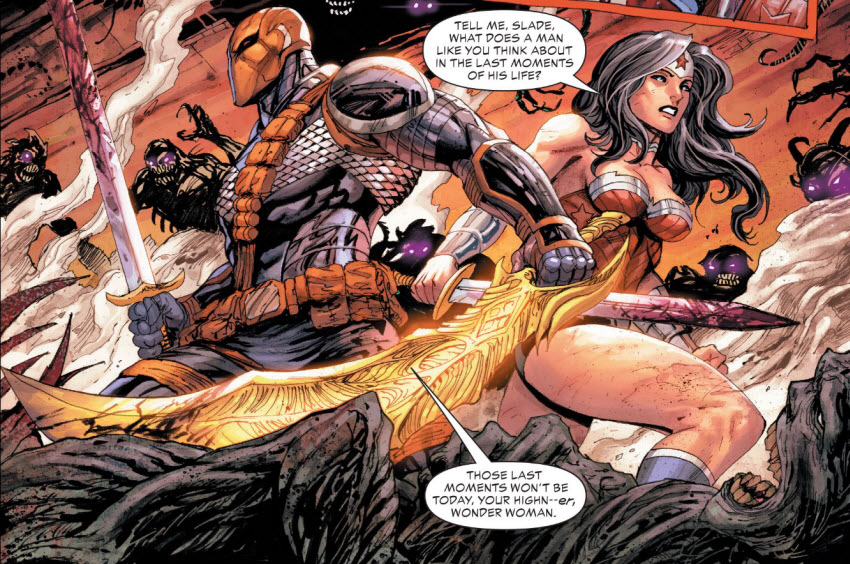

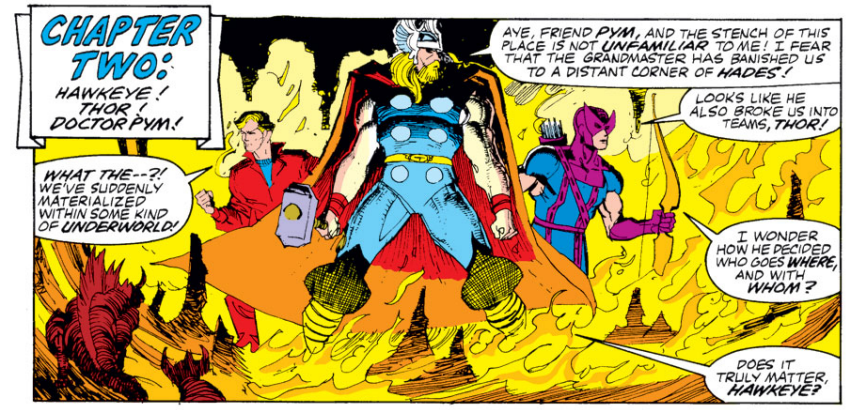
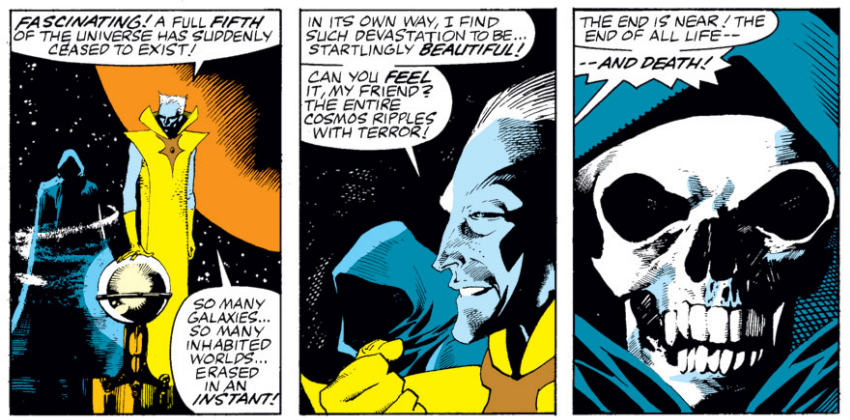


That Avengers Annual was so crazy. Funnily enough, I had read CONTEST OF CHAMPIONS, but when I read the follow-up Annual, I don’t think I drew the conclusion that they were tying up Contest of Champions.
. . .and man, those were some interesting artist/inker combinations. I always felt sad Kevin Nowlan never got a chance to do a Marvel Dracula comic.
Plus, the definitive moment for that incarnation of Hawkeye! That was a dumb fun comic.
A carny to the end. :)
I have always liked the Annuals for all the reasons you mention. The self contained aspect and the giant size aspect of the story and the book itself. There was always something appealing about the chunkiness of the story and the fact that the story was different from the regular book. I always liked that there were guest stars or a new villain or hero was introduced. Today when i rummage through bargain boxes and the cheapo bins it is the annuals or one shots I grab first. The self contained component makes them must buys.
Yes! Ditto for sales on Comixology.